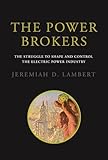The power brokers : the struggle to shape and control the electric power industry / Jeremiah D. Lambert.
Material type: TextLanguage: English Publisher: Cambridge, Massachusetts ; London, England : MIT Press, 2016Description: xiv, 379 pages : illustrations ; 24 cmContent type:
TextLanguage: English Publisher: Cambridge, Massachusetts ; London, England : MIT Press, 2016Description: xiv, 379 pages : illustrations ; 24 cmContent type: - text
- unmediated
- volume
- 9780262529785 (pbk)
- 0262529785 (pbk)
- 333.793/20973
- HD 9685 L222p 2016
| Item type | Current library | Home library | Collection | Shelving location | Call number | Copy number | Status | Date due | Barcode |
|---|---|---|---|---|---|---|---|---|---|
 Libro
Libro
|
Biblioteca Juan Bosch | Biblioteca Juan Bosch | Ciencias Sociales | Ciencias Sociales (3er. Piso) | HD 9685 L222p 2016 (Browse shelf(Opens below)) | 1 | Available | 00000160016 |
Browsing Biblioteca Juan Bosch shelves, Shelving location: Ciencias Sociales (3er. Piso), Collection: Ciencias Sociales Close shelf browser (Hides shelf browser)

|

|

|

|
No cover image available |

|

|
||
| HD 9685 K26 2003 Keeping the lights on power sector reform in Latin America / | HD 9685 K61f 2004 Fundamentals of power system economics / | HD 9685 L222c 2001 Creating competitive power markets : the PJM model / | HD 9685 L222p 2016 The power brokers : the struggle to shape and control the electric power industry / | HD 9685 M689 1994 La modernización del sector eléctrico, 1988-1994. | HD 9685 M963e 1982 Electricy pricing : theory and case studies / | HD 9685 O15 2018 Ocaso de un paradigma : hacia un nuevo modelo eléctrico / |
Includes bibliographical references and index.
Samuel Insull, architect and prime builder of the electric utility business in the United States --
David Lilienthal and the era of public power --
Bonneville Power: overreach and disaster --
Paul Joskow and the intellectual blueprint for industry reform --
Ken Lay: competition betrayed --
Amory Lovins: prophet of a new order --
Jim Rogers and the politics of accommodation.
For more than a century, the interplay between private, investor-owned electric utilities and government regulators has shaped the electric power industry in the United States. Provision of an essential service to largely dependent consumers invited government oversight and ever more sophisticated market intervention. The industry has sought to manage, co-opt, and profit from government regulation. In The Power Brokers, Jeremiah Lambert maps this complex interaction from the late nineteenth century to the present day. Lambert's narrative focuses on seven important industry players: Samuel Insull, the principal industry architect and prime mover; David Lilienthal, chairman of the Tennessee Valley Authority (TVA), who waged a desperate battle for market share; Don Hodel, who presided over the Bonneville Power Administration (BPA) in its failed attempt to launch a multi-plant nuclear power program; Paul Joskow, the MIT economics professor who foresaw a restructured and competitive electric power industry; Enron's Ken Lay, master of political influence and market-rigging; Amory Lovins, a pioneer proponent of sustainable power; and Jim Rogers, head of Duke Energy, a giant coal-fired utility threatened by decarbonization. Lambert tells how Insull built an empire in a regulatory vacuum, and how the government entered the electricity marketplace by making cheap hydropower available through the TVA. He describes the failed overreach of the BPA, the rise of competitive electricity markets, Enron's market manipulation, Lovins's radical vision of a decentralized industry powered by renewables, and Rogers's remarkable effort to influence cap-and-trade legislation. Lambert shows how the power industry has sought to use regulatory change to preserve or secure market dominance and how rogue players have gamed imperfectly restructured electricity markets. Integrating regulation and competition in this industry has proven a difficult experiment.--


There are no comments on this title.